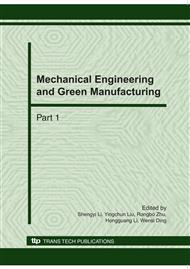[1]
T.Y. Tee, H.S. Ng, C.T. Lim, E. Pek and Z.W. Zhong. Microelectronics Reliability, Vol. 44 (2004), No. 7, pp.1131-1142.
DOI: 10.1016/j.microrel.2004.03.005
Google Scholar
[2]
D.Y.R. Chong, F.X. Che, J.H.L. Pang, K. Ng, J.Y.N. Tan and P.T.H. Low. Microelectronics Reliability, Vol. 46 (2006), No. 7, pp.1160-1171.
DOI: 10.1016/j.microrel.2005.10.011
Google Scholar
[3]
E. H Wong, S.K. W Seah, W.D. V Driel, J.F.J.M. Caers, N. Owerns and Y.S. Lai. Microelectronics Reliability, Vol. 49 (2009), No. 1, pp: 139-149.
DOI: 10.1016/j.microrel.2008.12.001
Google Scholar
[4]
C.T. Lim, Y.M. Teo, and V.P.W. Shim. IEEE Transactions on Components and Packaging Technologies, Vol. 25 (2002), No. 3, pp.478-485.
Google Scholar
[5]
Q. Yu, H. Kikuchi, S. Ikeda, M. Shiratori, M. Kakino and N. Fujiwara. Proc. of Inter Society Conference on Thermal Phenomena, Vol. 1 (2002), pp.953-960.
Google Scholar
[6]
T.Y. Tee, J. Luan, E. Pek, C.T. Lim and Z.W. Zhong. Proc. 54th Electronic Components and Technology Conference (ECTC), Vol. 1(2004), pp.1088-1094.
Google Scholar
[7]
W. Ren, J.J. Wang and T. Reinikainen. Proc. 6th Electronics Packaging Technology Conference (EPTC), Vol. 1(2004), pp.541-546.
Google Scholar
[8]
J.F. Zhao and Garner L.J. Proc. 56th Electronic Components and Technology Conference (ECTC), Vol. 1(2006), pp.436-442.
Google Scholar
[9]
F.X. Che, J.H.L. Pang, W.H. Zhu, W Sun. A. Sun, C.K. Wang and H.B. Tan. Proc 57th Electronic Component and Technology Conference, Vol. 1 (2007), pp.528-535.
Google Scholar
[10]
Y.Q. Wang, K.H. Low, F.X. Che, H.L.J. Pang and S.P. Yeo. Proc. 5th Electronics Packaging Technology Conference (EPTC), Vol. 1 (2003), pp.263-268.
Google Scholar
[11]
F. Liu, G. Meng, M. Zhao and J.F. Zhao. ASME Transaction J Electronic Packaging, Vol. 130 (2008), No. 2, pp: 021007.
Google Scholar
[12]
F. Liu, G. Meng and M. Zhao. Shanghai Jiao Tong University, Vol. 43 (2009), No. 5, pp: 727-730. (in Chinese).
Google Scholar
[13]
D.S. Sternberg. Vibration analysis for electronic equipment. (John Wiley & Sons; New York 1988).
Google Scholar


